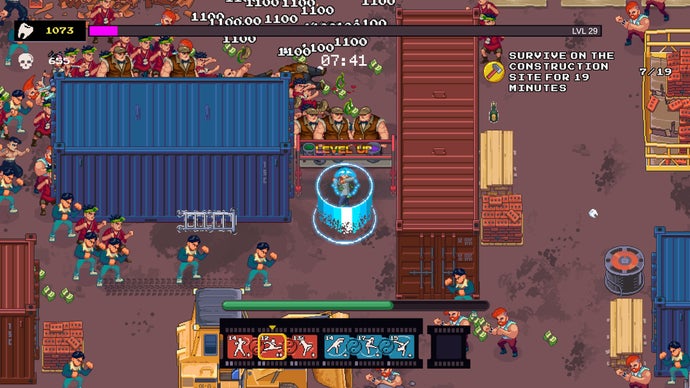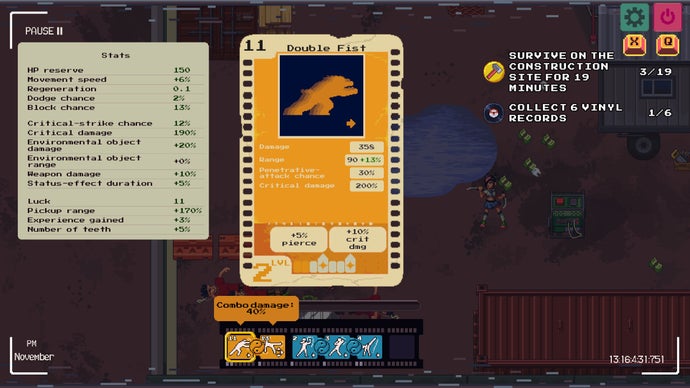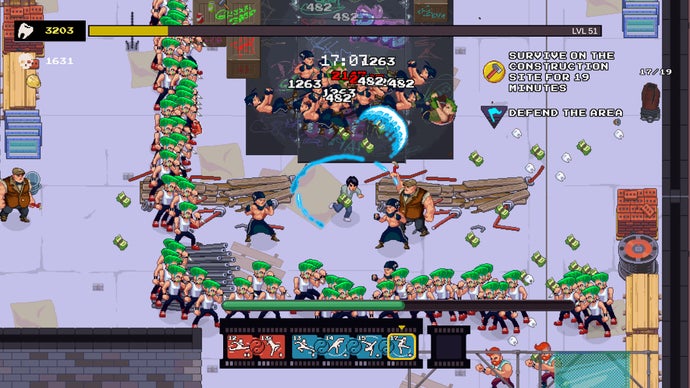I used to hate it when I’d see Vampire Survivors clones. I unashamedly loved that game and its lo-fi, fidget-spinnery brilliance, and I cackled when it displaced games hundreds of times its size in awards ceremonies. Look at this outrageously basic pretender getting all of the attention – it was anarchic and exciting. But because it had such a bright moment, copycats inevitably followed, slavering over their imagined piece of low-investment, high-return pie. That they would lick even crumbs from the plate irks me still; they offered nothing but greed.
That’s the mindset I watched Karate Survivor arrive with: a narrow-eyed martial arts scowl. Here’s a game brazen enough to ape even Vampire Survivors’ name – has it no shame? But I’ll tell you what: it’s great. It absolutely uses Vampire Survivors as a base but it does so more than that, too, and shows this sub-genre still has interesting things to offer when approached with the right mindset.
So how do you build on the Vampire Survivors idea? Simple: you introduce Jackie Chan. Not literally – I imagine that licence comes with a hefty price tag – but you riff on the same kind of late-80s, early-90s prop-flinging kung-fu action films Chan is famous for. Think Police Story or Rumble in the Bronx. Think Chan tumbling around kitchens while grabbing pots and pans and whacking people around the head with them. Think Chan clambering up ladders and then using the same ladders to spin around and wallop people with. Think overwhelming odds and yet, somehow, Chan succeeds.
That’s Karate Survivor, a sort of beat-’em-up re-thought with an auto-attack system a la Vampire Survivors, and coloured with a bright, stone-wash-jeans 90s aesthetic. It’s full of ridiculous roundhouses and stuffed with every kind of prop you can think of to hit someone with, a bit like the Yakuza and Like A Dragon games. You can run up and somersault off walls, tumble over tables, boot cement mixers, buckets, and destroy scenery – even spin around on office chairs to do a lazy kind of hurricane kick. Nearly everything you see, you can do something with.
But what I admire is how deeply the martial arts theme has been applied, right down to the core of the game. As you level, you unlock new moves (and passives) that you place in a hotbar and then they ‘play’, in a manner of speaking, in sequence. The trick is to string together attacks in their numbered order to trigger bonus effects – just as you try to string together complimentary sequences of martial arts moves in real-life. Hey, I did ninjutsu for five lessons so I think I know what I’m talking about. Match the colour of the moves together as well and the combo bonuses get even better – attacks gain shockwaves or glowing Hadouken-like extra effects – and these drastically improve your chances of flattening the ripped-sleeve, punk-haired horde surrounding you.



But do you go for the red attacks or the blue ones? Or hold out hopes for the lucrative yellow ones instead, which are incredibly powerful but also incredibly rare? Wait too long and you might miss the opportunity to build an entire string of attacks in a different colour. This is Karate Survivor’s strategy and it’s satisfying to chew on. Layer passive buff selection on top of that, and plotting routes around levels so as to maximise potential environmental damage and access powerful pick-ups, and there’s plenty to think about – as well as the base skill of timing your attack sequence right and staying out of reach of enemies.
I like it, and I also just like how it looks. The attention to detail in the animation is delightful, as you crouch and spin, starting a kick on the floor and then leaning forwards so your heel rises up into someone’s sneering chops, or as you lean backwards and kick and punch in all directions like the wonderful actor Michelle Yeoh. Impossible acrobatics: it’s the reason I watch martial arts films in the first place – I love seeing people do things I can’t.
It’s an impressive package. There are distinct levels styled as VHS tapes, as if you were putting in the cassettes to play them, and there are bosses with nice graphical splash-screens and multiple difficulty levels for when you feel like upping the challenge; though it’s quite hard as it is. Plus, the more you play, the greater number of new moves you’ll unlock, which are just as fun to see in action, whether they’re attacks – I love the helicopter kick – or environmental interactions like elbowing a seesawed piece of wood so it hits an enemy or pole-vaulting over gaps between buildings (a nifty escape route). It means that the more you play, the closer you get to ripping around a level like a tornado, tumbling, flinging, striking and pulverising anything that comes for you. Just like Jackie Chan.
